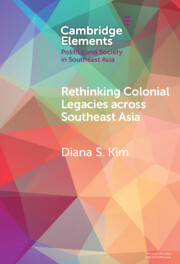506 results
7 - “They Have Made the Government Arbitrary Enough”
-
- Book:
- The Overseer State
- Published online:
- 21 March 2025
- Print publication:
- 27 March 2025, pp 281-323
-
- Chapter
- Export citation

The Overseer State
- Slavery, Indenture and Governance in the British Empire, 1812–1916
-
- Published online:
- 21 March 2025
- Print publication:
- 27 March 2025
General Introduction
-
- Book:
- The Cambridge History of the Papacy
- Published online:
- 28 February 2025
- Print publication:
- 20 March 2025, pp 1-32
-
- Chapter
- Export citation
General Introduction
-
- Book:
- The Cambridge History of the Papacy
- Published online:
- 28 February 2025
- Print publication:
- 20 March 2025, pp 1-32
-
- Chapter
- Export citation
General Introduction
-
- Book:
- The Cambridge History of the Papacy
- Published online:
- 28 February 2025
- Print publication:
- 20 March 2025, pp 1-32
-
- Chapter
- Export citation

Rethinking Colonial Legacies across Southeast Asia
- Through the Lens of the Japanese Wartime Empire
-
- Published online:
- 17 March 2025
- Print publication:
- 17 April 2025
-
- Element
-
- You have access
- HTML
- Export citation
Introduction: Race and Empire in Meiji Japan
-
- Journal:
- Asia-Pacific Journal / Volume 18 / Issue 20 / October 2020
- Published online by Cambridge University Press:
- 14 March 2025, e2
-
- Article
- Export citation
Taming the Seas: Empires of Fishing, Colonization and Ecological Collapse in the Western Pacific
-
- Journal:
- Asia-Pacific Journal / Volume 19 / Issue 12 / June 2021
- Published online by Cambridge University Press:
- 14 March 2025, e1
-
- Article
- Export citation
“The Backside of Japan,” Development, and Imperialism in Northeast Asia
-
- Journal:
- Asia-Pacific Journal / Volume 19 / Issue 6 / March 2021
- Published online by Cambridge University Press:
- 14 March 2025, e2
-
- Article
- Export citation
Orwell and Empire: A Conversation with Douglas Kerr
-
- Journal:
- Asia-Pacific Journal / Volume 20 / Issue 16 / September 2022
- Published online by Cambridge University Press:
- 14 March 2025, e5
-
- Article
- Export citation
Opium's Reverse Course: A Story of Shifting Winds
-
- Journal:
- Asia-Pacific Journal / Volume 20 / Issue 18 / October 2022
- Published online by Cambridge University Press:
- 14 March 2025, e3
-
- Article
- Export citation
Korea, A Unique Colony: Last to be Colonized and First to Revolt
-
- Journal:
- Asia-Pacific Journal / Volume 19 / Issue 21 / November 2021
- Published online by Cambridge University Press:
- 14 March 2025, e3
-
- Article
- Export citation
Chapter 12 - Territoriality: The Possessive Logics of American Placemaking
- from Part II - Issues
-
-
- Book:
- The Cambridge Companion to Nineteenth-Century American Literature and Politics
- Published online:
- 06 March 2025
- Print publication:
- 13 March 2025, pp 205-220
-
- Chapter
- Export citation

The Cambridge History of the Papacy
-
- Published online:
- 28 February 2025
- Print publication:
- 20 March 2025

The League of Nations
-
- Published online:
- 20 February 2025
- Print publication:
- 20 February 2025
-
- Element
-
- You have access
- Open access
- HTML
- Export citation
More of a Question than a Comment: A Response to Modernism, Empire, World Literature, by Joe Cleary
-
- Journal:
- Cambridge Journal of Postcolonial Literary Inquiry , First View
- Published online by Cambridge University Press:
- 20 February 2025, pp. 1-8
-
- Article
-
- You have access
- Open access
- HTML
- Export citation
The Federation persuasion: Identity, sovereignty, and decolonisation in the Indies East and West
-
- Journal:
- Journal of Global History , First View
- Published online by Cambridge University Press:
- 14 February 2025, pp. 1-18
-
- Article
-
- You have access
- Open access
- HTML
- Export citation
1 - Early Modern Exhibitions
-
- Book:
- Exhibitionist Japan
- Published online:
- 06 February 2025
- Print publication:
- 13 February 2025, pp 12-37
-
- Chapter
- Export citation
3 - Municipal Branding
-
- Book:
- Exhibitionist Japan
- Published online:
- 06 February 2025
- Print publication:
- 13 February 2025, pp 68-96
-
- Chapter
- Export citation
Chapter 2 - Society, Politics, and Specialized Knowledge in the Early Roman Empire
- from Part I
-
- Book:
- The <i>artes</i> and the Emergence of a Scientific Culture in the Early Roman Empire
- Published online:
- 22 March 2025
- Print publication:
- 13 February 2025, pp 39-78
-
- Chapter
- Export citation


